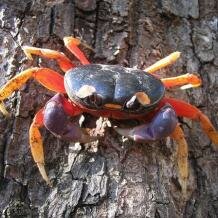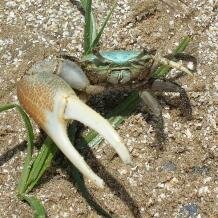Topic: Crustaceans: insights into convergence
Whilst predominantly marine, quite a number of crustaceans have invaded freshwater habitats and even more interestingly a few demonstrate terrestrialization, effectively freeing themselves from their aquatic ancestry.
Crustaceans are a major group of arthropods, perhaps most familiar from the crayfish, lobster and crab. Whilst predominantly marine, quite a number have invaded freshwater habitats and even more interestingly a few demonstrate terrestrialization and have effectively freed themselves from their aquatic ancestry. From the point of evolution they are also important because it is now generally agreed that the insects arose from within the crustaceans, and specifically perhaps the group known as the malacostracans. Like any major group the crustaceans are a rich source of information on convergence. Below are details about some of the more striking instances.
Crab-like body form
 The crab morph has evolved repeatedly, with examples from both the fossil record and extant faunas. In addition, and unsurprisingly, there has also been convergent evolution within the various groups of crabs, including the land-crabs and freshwater crabs. All crab morphs have evolved within the decapods, and another interesting convergent is the repeated evolution of the pectinate claw.
The crab morph has evolved repeatedly, with examples from both the fossil record and extant faunas. In addition, and unsurprisingly, there has also been convergent evolution within the various groups of crabs, including the land-crabs and freshwater crabs. All crab morphs have evolved within the decapods, and another interesting convergent is the repeated evolution of the pectinate claw.
Eusociality in alpheid shrimps
One of the most striking convergences concerns a group of sponge-dwelling shrimps, the alpheids, that have not only evolved eusociality, but managed it several times independently. Eusociality is a particularly interesting social system and is best known in the insects, where it is classically and independently developed in the bees, wasps, and ants, as well as other groups e.g. thrips. More remarkably, eusociality has also evolved in the mammals, famously with the subterranean mole-rats. In the alpheid shrimps we see many of the hall-marks of eusocial organization, diagnostically a single reproductive female (“the queen”) and large numbers of non-reproductive individuals. In addition, they show effective co-ordinated defence indicating social communication. Eusociality confers many evolutionary advantages, and is clearly why such groups as the ants and wasps are so successful. This applies also to the alpheid shrimps, where again we see a rise in dominance over other crustacean groups.
Social behaviour in fiddler crabs
 Several striking and important features of social behaviour are seen in the fiddler crabs. Perhaps the most interesting behaviour displayed by male fiddler crabs is lekking, a rampantly convergent behaviour found in many groups of animals including cephalopods, insects, fish, birds and mammals. Such behaviour is not so surprising, given the strongly territorial nature of these crabs and the famous claw dimorphism and its use in signalling. Fiddler crabs demonstrate a rich social repertoire, not least in the defence of their patch, erection of mud walls and other structures, as well as plugging of neighbours’ burrows. Not only are many of these behaviours surprisingly complex, but also have they evolved independently.
Several striking and important features of social behaviour are seen in the fiddler crabs. Perhaps the most interesting behaviour displayed by male fiddler crabs is lekking, a rampantly convergent behaviour found in many groups of animals including cephalopods, insects, fish, birds and mammals. Such behaviour is not so surprising, given the strongly territorial nature of these crabs and the famous claw dimorphism and its use in signalling. Fiddler crabs demonstrate a rich social repertoire, not least in the defence of their patch, erection of mud walls and other structures, as well as plugging of neighbours’ burrows. Not only are many of these behaviours surprisingly complex, but also have they evolved independently.
Sensory systems
In terms of sensory systems we find a number of most interesting convergences among the crustaceans. Perhaps most remarkable is the antennae of some penaeid shrimps that act as a direct analogue of the lateral line system, best known in the fish (and some amphibians), but also convergent in the cephalopods. Like many organisms the crustaceans have employed statoliths (statocysts) for balance, but more remarkably in some crabs the sense of balance is also assisted by a semi-circular canal arrangement, strikingly similar to that found in the vertebrates. Many crustaceans have excellent vision. It appears, for example, to be especially acute in the fiddler crabs (unsurprisingly given their visual displays). Perhaps the most remarkable visual system, however, is found in the mantis (or mantid) shrimps. Not only do these highly effective predators have a complex compound eye, but in addition they have colour vision.
Linked to this area is evolution of bioluminescence, which has certainly evolved independently many times in the crustaceans, for example in the myodocopid ostracodes (e.g. Cypridina, Vargula), halocyprid ostracods, decapod and mysid shrimps and copepods.
Articulated vs. hydrostatic skeletons
Like nearly all arthropods the crustaceans have an articulated (jointed) exoskeleton which itself is convergent having evolved independently in the kinorhynchs and extinct vetulicolians (stem-group deuterostomes that lived during the Cambrian). However, in moulting crabs which have a soft skeleton the support is transferred to a hydrostatic system that depends on the internal fluid pressure. Hydrostatic skeletons are rampantly convergent, and are most familiar in the worms, (e.g. annelids), the penis (again convergent), and elephant trunk.
Barnacles (Cirripedia)
 Barnacles are amongst the more peculiar of crustaceans, but are justly famous for the scrutiny they received from Charles Darwin. Various examples of convergent evolution are found. These include independent reduction in the number of shell plates, but much more astonishing is the discovery that the shell plates are not only phosphatic (as against the usual calcareous composition), but are strikingly convergent with lamellar bone. In addition, it seems that the abdomen (posterior region) of the barnacle body has been reduced to a vestigial state by the same genetic regulatory changes that underly loss of abdomen segments in other arthropods, for example in the mites Tetranychus urticae and Archegozetes longesitosus.
Barnacles are amongst the more peculiar of crustaceans, but are justly famous for the scrutiny they received from Charles Darwin. Various examples of convergent evolution are found. These include independent reduction in the number of shell plates, but much more astonishing is the discovery that the shell plates are not only phosphatic (as against the usual calcareous composition), but are strikingly convergent with lamellar bone. In addition, it seems that the abdomen (posterior region) of the barnacle body has been reduced to a vestigial state by the same genetic regulatory changes that underly loss of abdomen segments in other arthropods, for example in the mites Tetranychus urticae and Archegozetes longesitosus.
A trilobite-like crustacean
Finally, let us not forget the Jurassic isopod Cyclosphaeroma malogostianum, which converged on the trilobites!
Cite this web page
Map of Life - "Crustaceans: insights into convergence"
https://mapoflife.org/topics/topic_109_crustaceans-insights-into-convergence/
July 31, 2017

